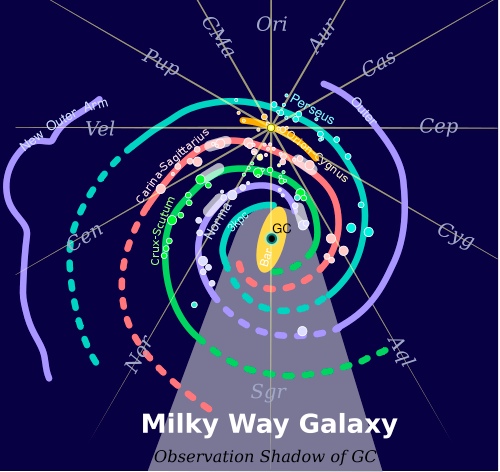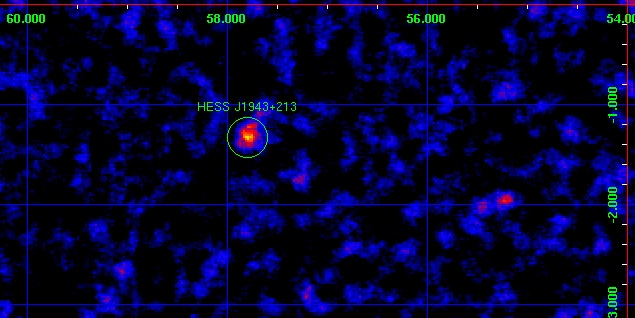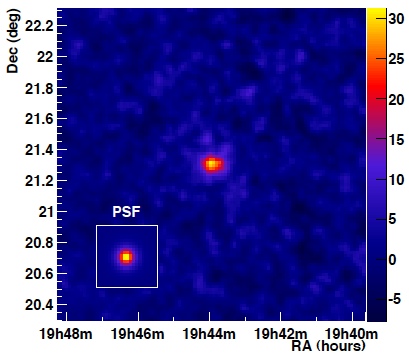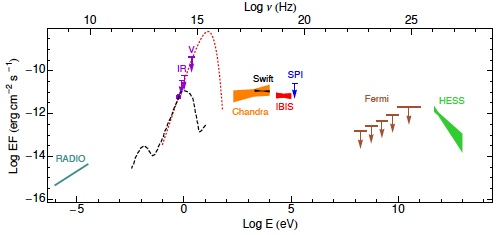HESS J1943+213: an extreme BL Lac object?
November 2010

Most of the gamma-ray sources detected in the H.E.S.S. survey of the Galaxy are extended, their size reflecting particles confined in the proximity of or propagating away from the accelerator. Apart from distant extragalactic sources, point-like sources of gamma-rays - on the scale of the 5 arc minute resolution of H.E.S.S. - are the exception; most of those, such as LS 5039 or PSR B1259-63 represent binary systems, where strong radiation fields or magnetic fields cause rapid energy loss of accelerated particles, preventing high-energy particles to move far from the source. The same mechanism can cause very young pulsar wind nebulae, such as the Crab nebula, to appear point-like.
A new point source of gamma rays, HESS J1943+213, located just below the band of the Galaxy at l = 57.76 degr., b = -1.29 degr was discovered in survey data collected between 2005 and 2008, and confirmed by dedicated observations in 2009 (Fig. 1, Fig. 2). The flux corresponds to about 1.5% of the Crab flux. Possible counterparts include an X-ray source IGR J19443+21173 seen in hard X-rays by INTEGRAL, as well as by Chandra, Swift and ROSAT (Tomsick et al. 2009, Landi et al. 2009), and the radio source NVSS J194356+211826 (Condon et al. 1998). The wide-band emission spectrum is shown in Fig. 2; remarkable is the flat X-ray spectrum which extends to beyond 100 keV.
What is the nature of this source? The emission spectrum resembles that of other known binary systems, but neither the gamma-ray source nor the X-ray source show indications of variability, which would be expected for a binary system. In addition, all known gamma-ray emitting binaries contain a massive, bright stellar companion visible in the infrared/optical band. No evidence of such a star is seen in the data, implying a minimum distance of 25 kpc, well beyond the outher edge of the Galaxy (top figure).
Concerning an explanation as a pulsar wind nebula, a small gamma-ray to X-ray flux implies a very young nebula with age of order 1000 years (Mattana et al. 2009). located far away (~15 kpc) based on its assumed similarity to Crab Nebula. However, the gamma-ray spectrum of HESS J1943+213 is steeper than that of typical pulsar wind nebulae.
The most likely explanation is hence that HESS J1943+213 is an extragalactic object seen through the Galaxy; given the number of extragalactic gamma-ray sources, it is not unlikely that one appears in the band of the Galaxy. Active Galactic Nuclei (AGN) provide the bulk of extragalactic sources; they usually feature a double-humped spectrum with one peak in the X-ray region and one in the gamma-ray region, explained as synchrotron emission and Compton upscattering by high-energy electrons. With its X-ray spectrum extending into the 100 keV range, HESS J1943+213 would be classified as an extreme BL Lac object, at the extreme end of the sequence of gamma-emitting AGN (Ghisellini 1999).
Reference: H.E.S.S. collaboration, H. Abramowski et al., in preparation.


